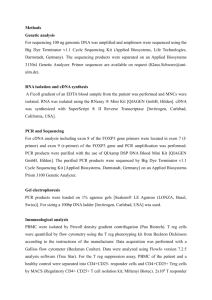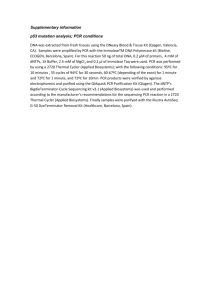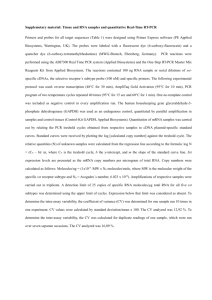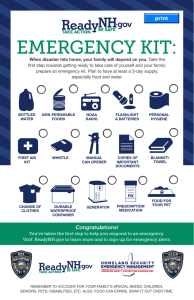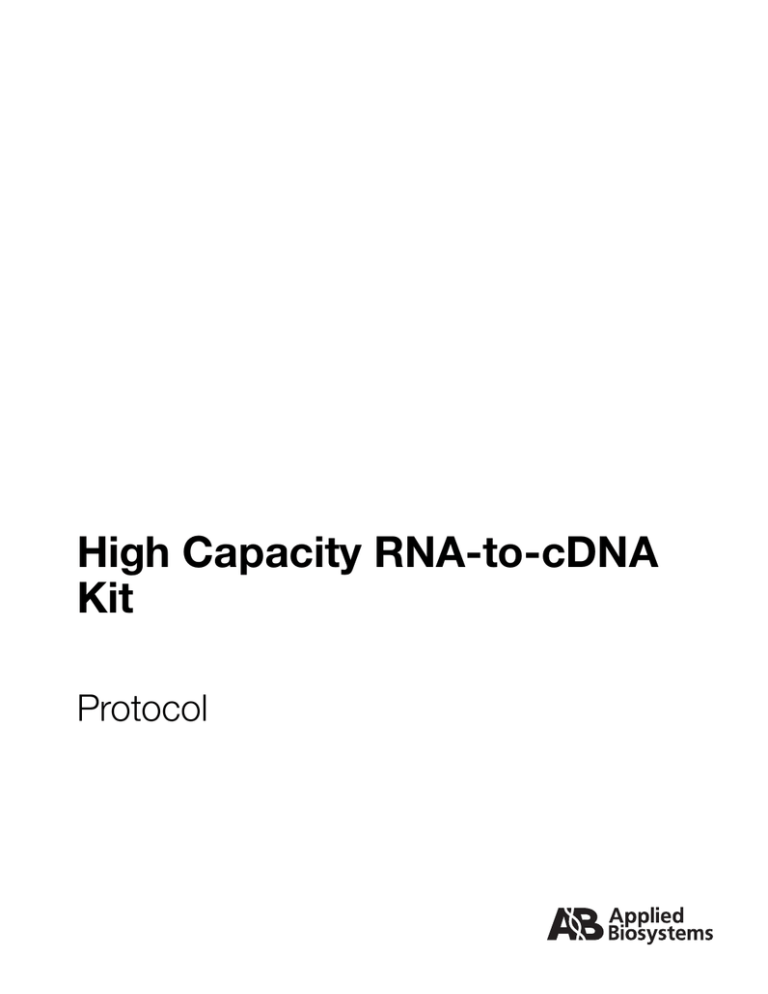
High Capacity RNA-to-cDNA
Kit
Protocol
© Copyright 2007, Applied Biosystems. All rights reserved.
For Research Use Only. Not for use in diagnostic procedures.
Information in this document is subject to change without notice. Applied Biosystems assumes no responsibility for any errors that
may appear in this document.
APPLIED BIOSYSTEMS DISCLAIMS ALL WARRANTIES WITH RESPECT TO THIS DOCUMENT, EXPRESSED OR
IMPLIED, INCLUDING BUT NOT LIMITED TO THOSE OF MERCHANTABILITY OR FITNESS FOR A PARTICULAR
PURPOSE. IN NO EVENT SHALL APPLIED BIOSYSTEMS BE LIABLE, WHETHER IN CONTRACT, TORT, WARRANTY,
OR UNDER ANY STATUTE OR ON ANY OTHER BASIS FOR SPECIAL, INCIDENTAL, INDIRECT, PUNITIVE,
MULTIPLE OR CONSEQUENTIAL DAMAGES IN CONNECTION WITH OR ARISING FROM THIS DOCUMENT,
INCLUDING BUT NOT LIMITED TO THE USE THEREOF.
TRADEMARKS:
Applera, Applied Biosystems, AB (Design), and GeneAmp are registered trademarks and MicroAmp and Veriti are trademarks of
Applera Corporation or its subsidiaries in the US and/or certain other countries.
TaqMan is a registered trademark of Roche Molecular Systems, Inc.
All other trademarks are the sole property of their respective owners.
Part Number 4387951 Rev. C
03/2008
Contents
1
Preface . . . . . . . . . . . . . . . . . . . . . . . . . . . . . . . . . . . . . . . . . v
Safety . . . . . . . . . . . . . . . . . . . . . . . . . . . . . . . . . . . . . . . . . . . . . . . . . . . . v
How to Obtain Support . . . . . . . . . . . . . . . . . . . . . . . . . . . . . . . . . . . . . . . x
High Capacity RNA-to-cDNA Kit Protocol . . . . . . . . . . . . . 1
Overview . . . . . . . . . . . . . . . . . . . . . . . . . . . . . . . . . . . . . . . . . . . . . . . . . . 1
Good Laboratory Practices . . . . . . . . . . . . . . . . . . . . . . . . . . . . . . . . . . . . 2
Materials and Equipment . . . . . . . . . . . . . . . . . . . . . . . . . . . . . . . . . . . . . 3
Using the High Capacity RNA-to-cDNA Kit . . . . . . . . . . . . . . . . . . . . . . . 6
Appendix A, Examples of cDNA Yields from
Reverse Transcription . . . . . . . . . . . . . . . . . . . . . . . . . . . 11
Index . . . . . . . . . . . . . . . . . . . . . . . . . . . . . . . . . . . . . . . . . . 17
High Capacity RNA-to-cDNA Kit Protocol
CONFIDENTIAL — For AB Internal Use Only. Do Not Distribute.
iii
Contents
iv
High Capacity RNA-to-cDNA Kit Protocol
CONFIDENTIAL — For AB Internal Use Only. Do Not Distribute.
Preface
This preface covers:
Safety. . . . . . . . . . . . . . . . . . . . . . . . . . . . . . . . . . . . . . . . . . . . . . . . v
How to Obtain Support . . . . . . . . . . . . . . . . . . . . . . . . . . . . . . . . . . x
Safety
Safety Alert
Words
Four safety alert words appear in Applied Biosystems user
documentation at points in the document where you need to be aware
of relevant hazards. Each alert word—IMPORTANT, CAUTION,
WARNING, DANGER—implies a particular level of observation or
action, as defined below.
Definitions
IMPORTANT! – Indicates information that is necessary for proper
instrument operation, accurate chemistry kit use, or safe use of a
chemical.
– Indicates a potentially hazardous situation that,
if not avoided, may result in minor or moderate injury. It may also be
used to alert against unsafe practices.
– Indicates a potentially hazardous situation that,
if not avoided, could result in death or serious injury.
– Indicates an imminently hazardous situation
that, if not avoided, will result in death or serious injury. This signal
word is to be limited to the most extreme situations.
Chemical Hazard
Warning
CHEMICAL HAZARD. Some of the chemicals
used with Applied Biosystems instruments and protocols are
potentially hazardous and can cause injury, illness, or death.
High Capacity RNA-to-cDNA Kit Protocol
v
Preface
Chemical Safety
Guidelines
About MSDSs
To minimize the hazards of chemicals:
• Read and understand the Material Safety Data Sheets (MSDSs)
provided by the chemical manufacturer before you store, handle,
or work with any chemicals or hazardous materials. (See “About
MSDSs” on page vi.)
• Minimize contact with chemicals. Wear appropriate personal
protective equipment when handling chemicals (for example,
safety glasses, gloves, or protective clothing). For additional
safety guidelines, consult the MSDS.
• Minimize the inhalation of chemicals. Do not leave chemical
containers open. Use only with adequate ventilation (for
example, fume hood). For additional safety guidelines, consult
the MSDS.
• Check regularly for chemical leaks or spills. If a leak or spill
occurs, follow the manufacturer’s cleanup procedures as
recommended in the MSDS.
• Comply with all local, state/provincial, or national laws and
regulations related to chemical storage, handling, and disposal.
Chemical manufacturers supply current Material Safety Data Sheets
(MSDSs) with shipments of hazardous chemicals to new customers.
They also provide MSDSs with the first shipment of a hazardous
chemical to a customer after an MSDS has been updated. MSDSs
provide the safety information you need to store, handle, transport,
and dispose of the chemicals safely.
Each time you receive a new MSDS packaged with a hazardous
chemical, be sure to replace the appropriate MSDS in your files.
Obtaining
MSDSs
The MSDS for any chemical supplied by Applied Biosystems is
available to you free 24 hours a day. To obtain MSDSs:
1. Go to https://docs.appliedbiosystems.com/msdssearch.html
2. In the Search field of the MSDS Search page:
a. Type in the chemical name, part number, or other
information that you expect to appear in the MSDS of
interest.
b. Select the language of your choice.
c. Click Search.
vi
High Capacity RNA-to-cDNA Kit Protocol
Safety
3. To view, download, or print the document of interest:
a. Right-click the document title.
b. Select:
• Open – To view the document
• Save Target As – To download a PDF version of the
document to a destination that you choose
• Print Target – To print the document
4. To have a copy of an MSDS sent by fax or e-mail, in the Search
Results page:
a. Select Fax or Email below the document title.
b. Click RETRIEVE DOCUMENTS at the end of the
document list.
c. Enter the required information.
d. Click View/Deliver Selected Documents Now.
Note: For the MSDSs of chemicals not distributed by Applied
Biosystems, contact the chemical manufacturer.
Chemical Waste
Hazards
HAZARDOUS WASTE. Refer to Material
Safety Data Sheets and local regulations for handling and disposal.
CHEMICAL WASTE HAZARD. Wastes
produced by Applied Biosystems instruments are potentially
hazardous and can cause injury, illness, or death.
CHEMICAL STORAGE HAZARD. Never
collect or store waste in a glass container because of the risk of
breaking or shattering. Reagent and waste bottles can crack and leak.
Each waste bottle should be secured in a low-density polyethylene
safety container with the cover fastened and the handles locked in the
upright position. Wear appropriate eyewear, clothing, and gloves
when handling reagent and waste bottles.
High Capacity RNA-to-cDNA Kit Protocol
vii
Preface
Chemical Waste
Safety Guidelines
Waste Disposal
To minimize the hazards of chemical waste:
• Read and understand the Material Safety Data Sheets (MSDSs)
provided by the manufacturers of the chemicals in the waste
container before you store, handle, or dispose of chemical waste.
• Provide primary and secondary waste containers. (A primary
waste container holds the immediate waste. A secondary
container contains spills or leaks from the primary container.
Both containers must be compatible with the waste material and
meet federal, state, and local requirements for container
storage.)
• Minimize contact with chemicals. Wear appropriate personal
protective equipment when handling chemicals (for example,
safety glasses, gloves, or protective clothing). For additional
safety guidelines, consult the MSDS.
• Minimize the inhalation of chemicals. Do not leave chemical
containers open. Use only with adequate ventilation (for
example, fume hood).For additional safety guidelines, consult
the MSDS.
• Handle chemical wastes in a fume hood.
• After emptying the waste container, seal it with the cap
provided.
• Dispose of the contents of the waste tray and waste bottle in
accordance with good laboratory practices and local,
state/provincial, or national environmental and health
regulations.
If potentially hazardous waste is generated when you operate the
instrument, you must:
• Characterize (by analysis if necessary) the waste generated by
the particular applications, reagents, and substrates used in your
laboratory.
• Ensure the health and safety of all personnel in your laboratory.
• Ensure that the instrument waste is stored, transferred,
transported, and disposed of according to all local,
state/provincial, and/or national regulations.
IMPORTANT! Radioactive or biohazardous materials may require
special handling, and disposal limitations may apply.
viii
High Capacity RNA-to-cDNA Kit Protocol
Safety
Biological Hazard
Safety
BIOHAZARD. Biological samples such as
tissues, body fluids, infectious agents, and blood of humans and other
animals have the potential to transmit infectious diseases. Follow all
applicable local, state/provincial, and/or national regulations. Wear
appropriate protective equipment, which includes but is not limited
to: protective eyewear, face shield, clothing/lab coat, and gloves. All
work should be conducted in properly equipped facilities using the
appropriate safety equipment (for example, physical containment
devices). Individuals should be trained according to applicable
regulatory and company/institution requirements before working
with potentially infectious materials. Read and follow the applicable
guidelines and/or regulatory requirements in the following:
• U.S. Department of Health and Human Services guidelines
published in Biosafety in Microbiological and Biomedical
Laboratories
(stock no. 017-040-00547-4; http://bmbl.od.nih.gov)
• Occupational Safety and Health Standards, Bloodborne
Pathogens (29 CFR§1910.1030; http://www.access.gpo.gov/
nara/cfr/waisidx_01/ 29cfr1910a_01.html).
• Your company’s/institution’s Biosafety Program protocols for
working with/handling potentially infectious materials.
Additional information about biohazard guidelines is available at:
http://www.cdc.gov
High Capacity RNA-to-cDNA Kit Protocol
ix
Preface
How to Obtain Support
For the latest services and support information for all locations, go to
http://www.appliedbiosystems.com, then click the link for
Support.
At the Support page, you can:
• Search through frequently asked questions (FAQs)
• Submit a question directly to Technical Support
• Order Applied Biosystems user documents, MSDSs, certificates
of analysis, and other related documents
• Download PDF documents
• Obtain information about customer training
• Download software updates and patches
In addition, the Support page provides access to worldwide telephone
and fax numbers to contact Applied Biosystems Technical Support
and Sales facilities.
x
High Capacity RNA-to-cDNA Kit Protocol
High Capacity RNA-to-cDNA Kit
Protocol
Overview
Purpose of the
High Capacity
RNA-to-cDNA Kit
Kit Features
The High Capacity RNA-to-cDNA Kit contains all the reagents
needed for reverse transcription (RT) of total RNA to single-stranded
cDNA using a reaction size of 20 µL.
Use the kit for:
• Quantitatively converting up to 2 µg (for a 20-µL reaction) of
total RNA to cDNA
• Generating single-stranded cDNA suitable for quantitative PCR
applications
• Generating single-stranded cDNA suitable for short- or
long-term storage
About This
Protocol
This protocol describes:
• Procedures for using the kits
• Recommendations for using the cDNA created using the kits
• Examples of cDNA conversion performance obtained using
the kits
High Capacity RNA-to-cDNA Kit Protocol
1
Good Laboratory Practices
Good Laboratory Practices
PCR Good
Laboratory
Practices
PCR assays require special laboratory practices to avoid false
positive amplifications (Kwok and Higuchi, 1989). The high
throughput and repetition of these assays can lead to amplification of
a single DNA molecule (Saiki et al., 1985; Mullis and Faloona,
1987).
• Wear a clean lab coat (not previously worn while handling
amplified PCR products or used during sample preparation) and
clean gloves when preparing samples for PCR amplification.
• Change gloves whenever you suspect that they are
contaminated.
• Maintain separate areas, dedicated equipment, and supplies for:
– Sample preparation and PCR setup
– PCR amplification and post-PCR analysis
• Never bring amplified PCR products into the PCR setup area.
• Open and close all sample tubes and reaction plates carefully.
Do not splash or spray PCR samples.
• Keep reactions and components sealed as much as possible.
• Use positive-displacement pipettes or aerosol-resistant pipette
tips.
• Clean lab benches and equipment periodically with freshly
diluted 10% chlorine bleach solution.
Bibliography
Kwok, S. and Higuchi, R. 1989. Avoiding false positives with PCR.
Nature 339:237-238.
Mullis, K.B. and Faloona, F.A. 1987. Specific synthesis of DNA in
vitro via a polymerase-catalyzed chain reaction. Methods Enzymol.
155:335-350.
Saiki, R.K., Scharf, S., Faloona,F., et al., 1985. Enzymatic
amplification of β-globin genomic sequences and restriction site
analysis for diagnosis of sickle cell anemia. Science 230:1350-1354.
2
High Capacity RNA-to-cDNA Kit Protocol
Materials and Equipment
Materials and Equipment
Kit Components
Components of the High Capacity RNA-to-cDNA Kit (Applied
Biosystems 4387406) are listed in Table 1.
Table 1
Kit components
Quantity in
50 reaction kit
Component
2✕ RT Buffer Mix
1 bottle, 500 µL
20✕ RT Enzyme Mix
Kit Storage
1 tube, 50 µL
Store all kit components at –15 to –25 °C (refer to real-time
protocol).
Note: RT Buffer Mix can be stored at 2 to 8 °C for up to 6 months.
Equipment and
Materials
Required but
Not Supplied
Table 2
Required equipment
Equipment
Source
Thermal cycler (one of the following):
• Applied Biosystems 9800 Fast
Thermal Cycler with 96-Well Aluminum
Sample Block Module
Applied Biosystems
(PN 4352604)
• GeneAmp ® PCR System 9700
Thermal Cycler
See your
Applied Biosystems
sales representative
• Veriti™ 96-Well Fast Thermal Cycler
Applied Biosystems
(PN 4375305)
• Veriti™ 96-Well Thermal Cycler
Applied Biosystems
(PN 4375786)
Centrifuge with 96-well adapter
Major laboratory supplier
(MLS)
Microcentrifuge
MLS
Vortexer
MLS
High Capacity RNA-to-cDNA Kit Protocol
3
Materials and Equipment
Table 3
Required materials
Materials/Consumables
MicroAmp™ Fast 96-Well Reaction Plate
Applied Biosystems
(PN 4346907)
MicroAmp™ Fast 96-Well Reaction Plate
with Bar Code
Applied Biosystems
(PN 4346906)
MicroAmp™ Optical 96-Well Reaction Plate
Applied Biosystems
(PN N8010560)
MicroAmp™ 8-tube strip
Applied Biosystems
(PN N8010580)
MicroAmp™ Fast 8-tube strip
Applied Biosystems
(PN 4358203)
MicroAmp™ 8-cap strip
Applied Biosystems
(PN N8010535)
Clear adhesive film
Applied Biosystems
(PN 4306311)
Optical adhesive film
Applied Biosystems
(PN 4360954)
MicroAmp™ Optical 96-Well Reaction Plates
and Optical Caps
Applied Biosystems
(PN 403012)
MicroAmp™ Optical Caps, 8 Caps/Strip
Applied Biosystems
(PN 4323032)
Reagent Tubes with Caps, 10-mL
Applied Biosystems
(PN 4305932)
RT-PCR Grade Water
4
Source
Ambion
(PN AM9935)
Pipette tips, aerosol-resistant
MLS
Pipettors, positive-displacement
MLS
Disposable gloves
MLS
Cap Installing Tool
Applied Biosystems
(PN 4330015)
Adhesive Seal Applicator
Applied Biosystems
(PN 4333183)
High Capacity RNA-to-cDNA Kit Protocol
Materials and Equipment
Table 3
Required materials (continued)
Materials/Consumables
Source
MicroAmp™ Fast Optical 48-Well
Reaction Plate
Applied Biosystems
(PN 4375816)
MicroAmp™ Fast 8-Tube Strip (0.1mL)
Applied Biosystems
(PN 4358293)
MicroAmp™ Optical 8-Cap Strip
Applied Biosystems
(PN 4323032)
MicroAmp® Fast Reaction Tube with
Cap (0.1mL)
Applied Biosystems
(PN 4358297)
MicroAmp™ 48-Well Optical Adhesive Film
Applied Biosystems
(PN 4375323)
(PN 4375928)
MicroAmp™ Fast 48-Well Tray
Applied Biosystems
(PN 4375282)
MicroAmp™ 48-Well Base Adaptor
Applied Biosystems
(PN 4375284)
MicroAmp™ 96-Well Support Base
Applied Biosystems
(PN 4379590)
High Capacity RNA-to-cDNA Kit Protocol
5
Using the High Capacity RNA-to-cDNA Kit
Using the High Capacity RNA-to-cDNA Kit
Overview
To synthesize single-stranded cDNA from total RNA using the RNAto-cDNA Kit:
+ RT Reaction
- RT Reaction
2X RT Buffer + 20X RT Enzyme
2X RT Buffer + H2O
RT control mix
+
RNA sample
RT master mix
+
RNA sample
Aliquot to reaction plate
1
2
3
4
5
6
7
8
9
10
11
12
1
A
384-well plate
2
3
4
5
6
7
8
9
10
11
12
A
B
or
1
or
D
or
C
D
E
E
F
F
G
G
H
H
3
4
5
6
7
8
B
C
D
and
E
F
96-well
Fast plate
96-well plate
2
A
B
C
48-well
Fast plate
8-cap and tube
strip
Preform RT reaction
Use cDNA for quantitative
or other real time PCR applications
Store the cDNA PCR master mix between
-15 to -25 ° C (refer to real-time protocol)
Real-Time PCR instrument
RNA Template
Guidelines
For optimal performance of the RNA-to-cDNA Kit, Applied
Biosystems recommends using RNA that is:
• Free of inhibitors of reverse transcription and PCR
• Dissolved in TE Buffer or PCR-compatible buffer
• Free of RNase activity
6
High Capacity RNA-to-cDNA Kit Protocol
Using the High Capacity RNA-to-cDNA Kit
Input Amount of
Total RNA
Preparing the RT
Reaction
Use up to 2 µg of total RNA per 20-µL reaction.
Prepare the RT reaction mix using the kit components before
preparing the reaction plate.
To prepare the RT reaction mix (per 20-µL reaction):
1. Allow the kit components to thaw on ice.
2. Referring to the table below, calculate the volume of
components needed to prepare the required number of
reactions.
Note: Prepare the RT reaction on ice.
Component
Volume/Reaction (µL)
− RT
+RT
2✕ RT Buffer
20✕ RT Enzyme Mix
Nuclease-free H2O
Sample
Total per Reaction
10.0
10.0
1.0
−
Q.S. ‡ to 20 µL
Q.S. to 20 µL
up to 9 µL
up to 9 µL
20.0
20.0
‡ Quantity Sufficient
IMPORTANT! Include additional reactions in the
calculations to provide excess volume for the loss that occurs
during reagent transfers.
CHEMICAL HAZARD. 2✕ RT Buffer
may cause eye, skin, and respiratory tract irritation. Read the
MSDS, and follow the handling instructions. Wear
appropriate eyewear, clothing, and gloves.
1. Mix gently and place the reaction mix on ice.
Preparing the
cDNA Reverse
Transcription
Reactions
To prepare the cDNA RT reactions:
1. Aliquot 20 µL of RT reaction mix into each well, or tube.
High Capacity RNA-to-cDNA Kit Protocol
7
Using the High Capacity RNA-to-cDNA Kit
To prepare the cDNA RT reactions: (continued)
2. Seal the plates or tubes.
3. Briefly centrifuge the plate or tubes to spin down the
contents and to eliminate air bubbles.
4. Place the plate or tubes on ice until you are ready to load the
thermal cycler or Applied Biosystems Real-Time PCR
system.
Performing
Reverse
Transcription
To perform reverse transcription:
1. Program the thermal cycler conditions using one of the
thermal cyclers listed in Table 2 on page 3.
IMPORTANT! These conditions are optimized for use with
the High Capacity RNA-to-cDNA Kit.
Temperature (°C)
Time
Step 1
Step 2
Step 3
37
95
4
60 min
5 min
∞
2. Set the reaction volume to 20 µL.
3. Load the reactions into the thermal cycler or
Applied Biosystems Real-Time PCR system.
4. Start the reverse transcription run.
8
High Capacity RNA-to-cDNA Kit Protocol
Using the High Capacity RNA-to-cDNA Kit
Storing cDNA
Reverse
Transcription
Reactions
You can store cDNA RT plates or tubes prepared using the High
Capacity RNA-to-cDNA Kit for short-term or long-term storage.
Storage Duration
Short-term (up to 24 hours before use)
Long-term
Storage Temperature
(°C)
2 to 8
− 15 to − 25
IMPORTANT! If required, briefly centrifuge the archive plates or
tubes before storing to spin down the contents and to eliminate any
air bubbles.
High Capacity RNA-to-cDNA Kit Protocol
9
Using the High Capacity RNA-to-cDNA Kit
10
High Capacity RNA-to-cDNA Kit Protocol
Appendix A: Examples of cDNA Yields
from Reverse Transcription
Quantitative PCR
To determine the yield of the cDNA from the reverse transcription of
total RNA, use quantitative PCR to test various input amounts of
RNA for the cDNA yield of different gene targets.
The table below lists some targets and Applied Biosystems kits that
you can use to evaluate the yield of cDNA conversion.
Gene
Target
Kit
Applied Biosystems
Part Number
18S
TaqMan® Ribosomal RNA Control
Reagents
4308329
GAPDH
TaqMan® GAPDH Control Reagents
[Human]
402869
GAPDH
TaqMan® Rodent GAPDH Control
Reagents
4308313
β-actin
TaqMan® β-actin Detection
Reagents
401846
You can use other TaqMan® Gene Expression Assays to evaluate the
yield of cDNA conversion. For a list of available assays, visit
www.appliedbiosystems.com.
High Capacity RNA-to-cDNA Kit Protocol
11
Appendix A Examples of cDNA Yields from Reverse Transcription
Yields for
Different Targets
For the example in this appendix, the input total RNA was obtained
from human Raji cells, and the RNA was converted to cDNA using
the RNA-to-cDNA Kit.
Figure 1 shows an example of quantitative PCR results from the
cDNA for 4 different gene targets, which vary in expression levels.
Note: The amplicon for β2-microglobulin in this study was
specifically designed to be A/U rich.
The threshold cycle (CT) values are plotted against log scale RNA
input amounts of 1 pg to 1 µg in 20-µL reactions. The cDNA input is
20% of PCR reaction volume.
40
Assays
18S
GAPDH
ß-actin
ß-microglobulin
35
30
Ct
25
20
15
10
5
0
-1
0
1
2
3
4
5
6
Log Total RNA
Input(pg) /20 ul RT
Figure 1 The expected ΔCT values of 3.3 for each tenfold
increase in the RNA input quantity are obtained for 4 different RNA
transcripts converted to cDNA from different input quantities of
total RNA.
12
High Capacity RNA-to-cDNA Kit Protocol
Yield vs.
Reaction Time
To achieve optimal conversion, Applied Biosystems recommends
allowing reverse transcription to occur for 60 minutes at 37 °C.
Figures 2, 3, and 4 show CT values plotted against reaction time in
minutes for three different targets (18S, GAPDH, and
β2-microglobulin) and five input amounts of RNA in 20-µL
reactions.
18
Total RNA Input(pg)/20ul RT
200
2000
20000
200000
16
14
Ct
12
10
8
6
4
2
0
20
40
60
80
100
120
140
RT Time Minutes
Figure 2 The rate of conversion of 18S RNA to cDNA reaches a
maximum at 90 minutes or less with 0.2 to 200 ng of input RNA
(based on 20-µL reactions).
High Capacity RNA-to-cDNA Kit Protocol
13
Appendix A Examples of cDNA Yields from Reverse Transcription
30
Total RNA Input(pg)/20ul RT
200
2000
20000
200000
2000000
Ct
25
20
15
10
0
20
40
60
80
100
120
140
RT Time Minutes
Figure 3 The rate of conversion of GAPDH RNA to cDNA reaches
a maximum at 60 minutes or less at all RNA input levels (based on
20-µL reactions).
14
High Capacity RNA-to-cDNA Kit Protocol
30
Total RNA Input(pg)/20ul RT
200
2000
20000
200000
2000000
Ct
25
20
15
10
0
20
40
60
80
100
120
140
RT Time Minutes
Figure 4 The rate of conversion of β2-microglobulin RNA to
cDNA reaches a maximum at 60 minutes or less at all RNA input
levels (based on 20-µL reactions).
High Capacity RNA-to-cDNA Kit Protocol
15
Appendix A Examples of cDNA Yields from Reverse Transcription
16
High Capacity RNA-to-cDNA Kit Protocol
Index
A
H
Applied Biosystems
contacting x
Technical Support x
hazards, chemical waste vii
High Capacity RNA-to-cDNA Kit 3
B
biohazardous waste, handling viii
C
CAUTION, description v
cDNA reverse transcription (RT) reactions
preparing 7
storing 9
cDNA yields from reverse transcription,
examples 11
chemical safety vi
chemical waste
hazards vii
safety viii
I
IMPORTANT, description v
K
Kit Components 3
M
materials, required 4
MSDSs
description vi
obtaining vi, x
P
DANGER, description v
PCR good laboratory practices 2
performing reverse transcription 8
preparing
cDNA reverse transcription (RT) reactions 7
E
Q
equipment, required 3
quantitative PCR 11
G
R
guidelines
chemical safety vi
chemical waste disposal vii
chemical waste safety viii
radioactive waste, handling viii
required
equipment 3
materials 4
reverse transcription, performing 8
RNA-to-cDNA Kit
storing 3
D
High Capacity RNA-to-cDNA Kit Protocol
17
Index
S
safety
biological hazards ix
chemical waste vii
guidelines vi, vii, viii
storing
cDNA reverse transcription (RT) reactions 9
RNA-to-cDNA Kit 3
T
Technical Support, contacting x
training, information on x
W
WARNING, description v
waste disposal, guidelines viii
Y
yield of cDNA from RNA
yield vs. reaction time 13
yields for different targets 12
18
High Capacity RNA-to-cDNA Kit Protocol
Worldwide Sales and Support
Applied Biosystems vast distribution and
service network, composed of highly trained
support and applications personnel,
reaches 150 countries on six continents.
For sales office locations and technical support,
please call our local office or refer to our
Web site at www.appliedbiosystems.com.
Applera is committed to providing the
world’s leading technology and information
for life scientists. Applera Corporation
consists of the Applied Biosystems and
Celera businesses.
Headquarters
850 Lincoln Centre Drive
Foster City, CA 94404 USA
Phone: +1 650.638.5800
Toll Free (In North America): +1 800.345.5224
Fax: +1 650.638.5884
03/2008
www.appliedbiosystems.com
Part Number 4387951 Rev. C

